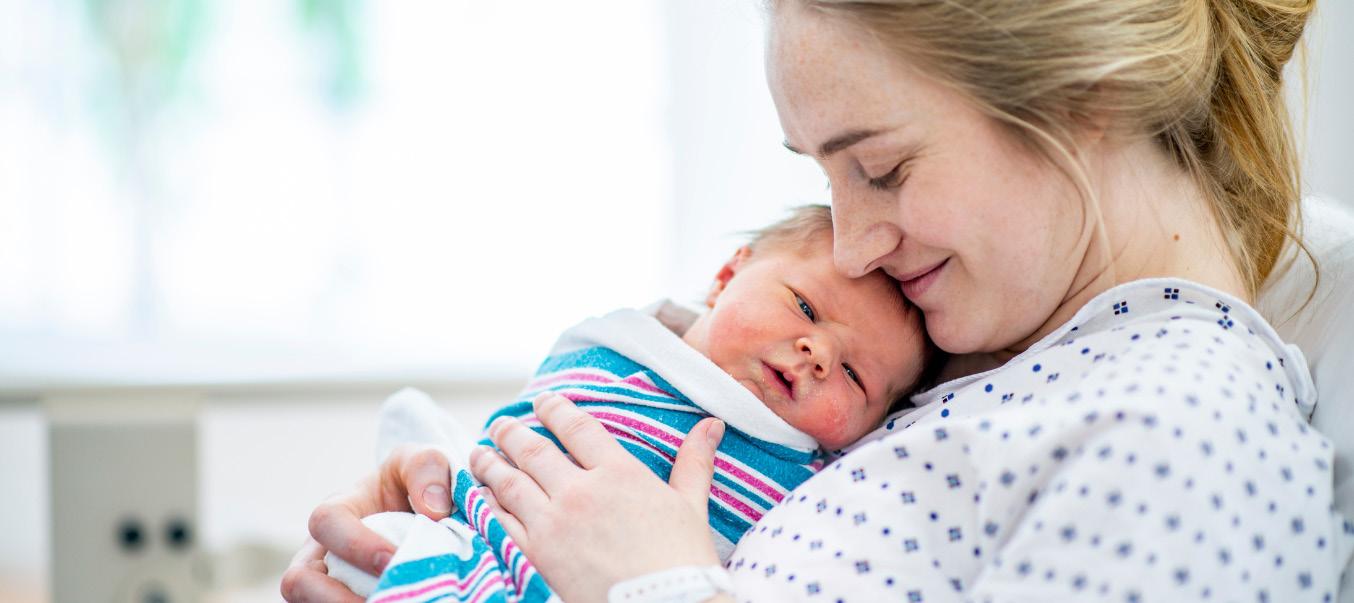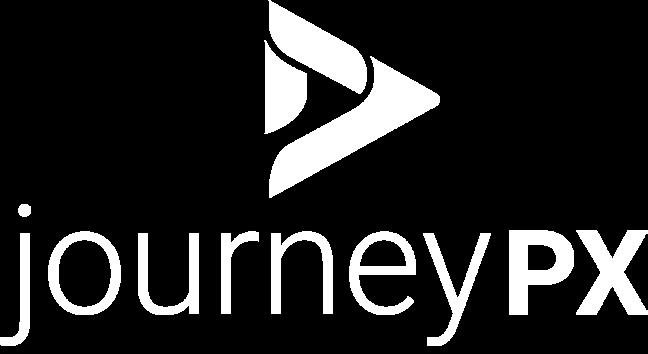WHITE PAPER
Key Benefits Journey PX Provides Mother Baby Units
 By Linda Robinson MSN, CPXP, RN and Ashton Elder MS
By Linda Robinson MSN, CPXP, RN and Ashton Elder MS
Patient education is an important and challenging component of care during hospitalization. Motherbaby units are an area where specialized healthcare staff nurtures and supports the mother-baby relationship, and education is a key component of their care. Mothers and babies are not in the hospital for long. However, during that brief period, they are a captive audience, and it is crucial that they get the education they need as well as the answers to any questions they may have before discharge. This education process should also extend to the father, family, and those who could potentially care for the newborn. Postpartum education is vital for the new mother’s ability to care for her newborn, family, and herself. Adjusting to life with a new baby is complex. It is important for mothers to feel confident. If they are unsure or have questions, they should be provided with the best resources.
Mothers often get advice from a variety of sources. The quality of this advice is not always consistent. There is a chance it may be outdated or inaccurate. This paper will discuss key areas of postpartum education that can be conveyed effectively prior to discharge. It will also discuss how the right technology can support this effort. Journey PX is a cloud hosted patient engagement platform that is accessed via the patient’s in room smart TV. The platform’s solutions have unique design features which make it an incredibly effective tool to assist hospitals and caregivers in this mission.
The curriculum included in hospital antepartum, intrapartum, and postpartum education is set according to the guidelines and recommendations from the Association of Women’s Health, Obstetrics and Neonatal Nurses (AWHONN), the American Academy of Pediatrics (AAP)1, the Centers for Disease Control (CDC)2 and the state in which the infant is born. As previously stated, there is a short window of time for new parent education to be completed. It is vital that health education be delivered at the right time and place. It is also critical that the education process is ongoing, pertinent, and impactful. Journey PX can deliver comprehensive, crucial information at the bedside in an automated fashion, supporting the healthcare staff in driving quality and safety. Delivering information in this way also promotes health literacy and helps close gaps in communication.
Journey PX uses cloud technology configurations to deliver patient education and engagement tools that are integrated with the hospital’s EMR and ADT. Journey PX can be accessed inside patients’ hospital rooms, clinics, and even follows patients home on their smart devices, emails, and patient portals.


Journey PX Connect, a video call solution that runs through the patient room TV and bedside pillow speaker, provides the mother with a fuller hospital experience that enables her to stay connected virtually with loved ones. Journey PX My Stay offers patients an extensive library of patient education videos that keep mothers informed and educated about their care throughout their stay. My Stay also allows vital health education to be delivered via email and text for parents, family, and other caregivers of the newborn. The education library can be embedded in the EMR and can be automated or manually deployed. Mothers can receive prompts and visual cues to engage them in their care. Prompts and cues include reminders to watch health education, assessment of patient understanding, and reminders to respond to a survey, or risk assessment for conditions such as Postpartum Depression, etc. The prompts, surveys, and risk assessments are customizable.
Since the newborn may be placed in the care of a variety of people, another beneficial aspect of Journey PX’s patient engagement solution is that it can assess the identity of who watches assigned health education and allows for it to be documented. This is beneficial for mother-baby units as it enables the healthcare team to be aware of which family members have been given key education. In addition to this capability, upon video completion Journey PX can assess and document learning responses in the EMR. Also, following completion of the education, the solution can deploy small informational pop-ups that display in a corner on the TV at timed intervals throughout the patient’s hospital stay, and a different popup is displayed every hour. The pop-ups are designed to reinforce the learned principles outlined in the educational video. For example, after the Safe Sleep video, the pop-ups are three separate images of a baby with the ABC’s of safe sleep messages messages: Baby Sleeps Alone, Baby Sleeps on Back, Baby Sleeps in Crib. Repetitive messages for a safe sleep campaign are believed to help lower the death rate. 3 These pop ups are also customizable.
My Stay also includes features that address service requests, patient services information, video calling, TV and entertainment, relaxation videos, and the Journey PX digital whiteboard, My Day, Today. Journey PX’s My Service Requests capability allows patients to contact the appropriate source for a request instead of contacting their nurse. For example: if their room needs tidying, patients can send a request straight to housekeeping. Service requests are customizable and provide nurses with the ability to off-load nonclinical tasks. My Day, Today displays vital real-time information for the patient and their care team, and keeps patients informed of their daily plan of care. My Day, Today is integrated with the EMR, therefore an accurate source of information which does not need to be updated manually by staff. This closes gaps in communication and decreases the risk of human error.
Journey PX solutions can also drive communication and crucial health education when the clinicians are not in the room and allow for secure virtual rounding and provider visits. The combination of these features saves clinicians valuable time and steps and provides patients with a richer patient experience. Journey PX understands why it is critical to educate parents and those who will care for the newborn and support the mother after discharge. Targeted and optimized education after the birth of a child helps prevent many risks, including those highlighted below.
Sudden Unexpected Infant Death
Sudden Unexpected Infant Death (SUID), which includes sudden infant death syndrome (SIDS), is the leading cause of injury death in infancy. Sleep is a big challenge for families with babies, but following safe sleep recommendations can prevent many SUID fatalities. Journey PX is committed to supporting healthcare in its quest to help mothers, fathers, families, and caregivers learn how babies can sleep safely so their parents can sleep soundly.
Breastfeeding
Inadequate breastfeeding practices significantly impair the health, development and survival of infants, children, and mothers.
Shaken Baby Syndrome
Abusive head trauma or Shaken Baby Syndrome (SBS) is the most common cause of death from child abuse. SBS is usually caused by a frustrated parent or caregiver who shakes a baby when it will not stop crying, or because of some other personal stress such as economic or relationship problems. SBS is preventable and education is a key aspect of a successful prevention plan. Hospital-based, parent education programs targeting parents of newborns have been proven effective in significantly reducing the incidence of abusive head injuries. 4Approximately 20 states have enacted legislation requiring hospitals to provide parents SBS education at varying degrees from comprehensive prevention programs to just offering education before they leave the hospital. Journey PX offers an effective way to do this in all states and in all hospitals. It also allows mothers to watch the video and then ask their nurse or provider questions. Research shows that screening an educational video on infant crying and the dangers of shaking and smothering within 1 week after delivery at maternity wards reduced the prevalence of selfreported shaking by 88% at 1 month of age. 5
Car Safety
Every state requires that all babies be in a car seat when they leave the hospital according to the Governors Highway Safety Association.9 Safety is crucial for hospital car seat requirements. Before discharge, most hospitals require parents to bring their infant car seats into their hospital rooms where nurses can inspect them to ensure they are up to date and help parents learn how to buckle their babies in properly. 6 A study conducted by the American Academy of Pediatrics (AAP) found that “virtually all new parents” are using car seats the wrong way, whether they are putting the chest clip in the wrong place or not pulling the straps tight enough, etc. 7
Maternal Post Birth Complications
Most women who give birth recover without problems. But any woman can have complications after the birth of a baby. Learning to recognize maternal post-birth warning signs and knowing what to do can save lives. 8
Mother baby units gain several significant benefits by partnering with Journey PX. Journey PX’s patient engagement technology solutions offer unique support that can mitigate serious preventable risks and save infant lives. Journey PX’s expert team is dedicated to the support of new parents, arming them with the vital information and education they need at key moments inside the hospital room and upon discharge. The team is also committed to aiding in the interoperability of hospital care teams by providing technology that closes gaps in communication, creates lean clinical workflows, and offloads nonclinical tasks.

References
1. “Neonatal Orientation and Education Program (NOEP).” AWHONN. Association of Women’s Health, Obstetrics and Neonatal Nurses , May 12, 2022. https://www.awhonn.org/education/neonatalorientation-and-education-program-fourth-edition-noep/.
2. “After the Baby Arrives.” Centers for Disease Control and Prevention. Centers for Disease Control and Prevention, July 11, 2022. https://www.cdc.gov/pregnancy/after.html.
3. Y. Moon, Rachel, Fern R. Hauck, and Eve R. Colson. “Safe Infant Sleep Interventions: What Is the Evidence for Successful Behavior Change?” Current Pediatric Reviews 12, no. 1 (2016): 67–75. https://doi.org/10.2174/1573396311666151026110148.
4. “Shaken Baby Syndrome - Centers for Disease Control and Prevention.” Shaken baby syndrome. CDC. Accessed January 17, 2023. https://www.cdc.gov/violenceprevention/pdf/SBSMediaGuide.pdf.
5. Fujiwara, Takeo, Aya Isumi, Makiko Sampei, Yusuke Miyazaki, Fujiko Yamada, Hisashi Noma, Kazuhide Ogita, and Nobuaki Mitsuda. “Effectiveness of an Educational Video in Maternity Wards to Prevent Self-Reported Shaking and Smothering during the First Week of Age: A Cluster Randomized Controlled Trial.” Prevention Science 21, no. 8 (2020): 1028–36. https://doi.org/10.1007/s11121-02001145-z.
6. Suglia, Casey. “Car Seat Rules Parents Need to Follow before Leaving the Hospital with Their Newborn.” Romper. Romper, January 31, 2022. https://www.romper.com/pregnancy/hospital-car-setrequirements.
7. KF;, Hoffman BD;Gallardo AR;Carlson. “Unsafe from the Start: Serious Misuse of Car Safety Seats at Newborn Discharge.” The Journal of pediatrics. U.S. National Library of Medicine. Accessed January 17, 2023. https://pubmed.ncbi.nlm.nih.gov/26707620/.
8. “Post-Birth Warning Signs Education Program.” AWHONN. Association of Women’s Health, Obstetric and Neonatal Nurses, September 2, 2022. https://www.awhonn.org/education/hospital-products/ post-birth-warning-signs-education-program/.
9. “Child Passenger Safety.” GHSA. Governors Highway Safety Association . Accessed January 18, 2023. https://www.ghsa.org/issues/child-passenger-safety#:~:text=GHSA%20Policy&text=Use%20 of%20a%20child%20safety,use%20of%20seat%20belts%20alone.&text=Booster%20seat%20 use%20reduces%20the,for%20children%20ages%204%2D8.
